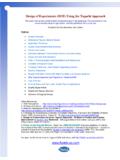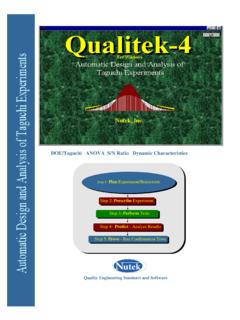Transcription of SAMPLE PMP PREPARATORY QUESTIONS AND …
1 SAMPLE PMP PREPARATORY QUESTIONS AND ANSWERS 160 Free PMP Exam Prep QUESTIONS (Obtained from PM Connection: ) 1. Regarding management and leadership all of the following are true except A. On a project, particularly a larger project, the project manager is generally expected to be the project's leader as well. B. Technical leadership is of primary importance in project management C. Managing is primarily concerned with consistently producing key results expected by stakeholders D. Leading involves establishing direction, aligning people, motivating and inspiring Answer: B 2. A company has to make a choice between two projects, because the available resources in money and kind are not sufficient to run both at the same project would take 9 months and would cost $250,000. The first project is a process optimization which would result in a cost reduction of $120,000 per benefit would be achieved immediately after the end of the project.
2 The second project would be the development of a new product which could produce the following net profits after the end of the project: 1 year:$ 15,000 2 year:$ 125,000 3 year:$ 220,000 Assumed is a discount rate of 5 % per at the present values of these projects' revenues in the first 3 years, what is true? A. Both projects are equally attractive. B. The first project is more attractive by C. The second project is more attractive by D. The first project is more attractive by Answer: D 3. A production process has been defined as part of an industrial equipment manufacturing process is intended to produce steel bolts with a length of 20 acceptable control limits are cm and cm. The measurements made at the end of the process yielded the following results: cm, cm, 19,995 cm, cm, cm, cm, cm, cm, cm, cm, cm.
3 What should be done? A. The process is under should not be adjusted. B. The process should be adjusted. C. The control limits should be adjusted. D. The measuring equipment should be recalibrated. Answer: B 4. What are the 4 stages of team development? A. Forming, Storming, Norming, Performing. B. Enthusiasm, Hope, Panic, Solution. C. Assignment, Kickoff, Training, Communicating. D. Direction, Motivation, Cooperation, Collaboration. Answer: A 5. During a software project Earned Value Analysis is performed and gives the following results: EV: 523,000; PV: 623,000; AC: 643,000. Which results are correct? A. CV: +120,000; SV: +100,000. B. CV: +100,000; SV: +120,000. C. CV: -100,000; SV: -120,000 D. CV: -120,000; SV: -100,000. Answer: D 6. Which of the following is not normally an element of the Project Charter? A. The formal authorization to apply organizational resources to project activities.
4 B. Work package descriptions. C. The business need that the project was undertaken to address. D. The product description or a reference to this document Answer: B 7. Which process is applied to break down the project into smaller, more manageable elements? A. Scope Planning. B. Activity Duration Estimating. C. Scope Definition. D. Scope Verification. Answer: C 8. Which of the following Tools and Techniques are part of Risk Management Planning? A. Risk planning meetings. B. Documentation reviews. C. Data precision rankings. D. Diagramming techniques. Answer: A 9. All of the following statements concerning project stakeholders are true except A. Differences between or among stakeholders should be resolved in favor of the customer. B. Managing stakeholder expectations may be difficult because stakeholders often have very different objectives, that may come into conflict.
5 C. Project stakeholders may influence the course of the project and its results. D. Differences between or among stakeholders should be resolved in the most cost efficient manner consistent with project objectives. Answer: D 10. Which of the following is the output of Source Selection? A. Proposals. B. Evaluation criteria. C. Contract negotiation. D. Contract. Answer: D 11. Which of the following statements is not true? A. Standards and regulations are mandatory. B. According to ISO, standards are not mandatory, but regulations are. C. Standards often begin as guidelines that are not later widespread adoption, they can become de facto regulations. D. Standards and regulations are socio-economic influences to a project. Answer: A 12. Which type of leadership is best suited for optimizing team performance in projects? A. Democratic leadership. B.
6 Participative leadership. C. Autocratic leadership. D. Benevolent authoritative leadership Answer: B 13. Where is the result node (outcome) shown on a typical Ishikawa or Fishbone diagram? A. Top. B. Bottom. C. Right hand side. D. Center. Answer: C 14. A project management team has subcontracted work to a service company. The process of ensuring that this service company's performance meets contractual requirements is called A. Contract Administration. B. Staff Acquisition. C. Contract Closeout. D. Contract Negotiation Answer: A 15. What are workarounds in project management? A. Workarounds are essentially the same as rework. B. Workarounds are alternative strategies. C. Workarounds are unplanned responses to emerging risks that were previously unidentified or accepted. D. Workarounds are activities performed according to applicable contingency plans Answer: C 16.
7 What are faits accomplis? A. A French dinner after a kick-off meeting. B. Unachievable deliverables. C. Accomplished objectives. D. Decisions made earlier which limit the options for decision making. Answer: d 17. During execution of a project which is performed for a customer on a T&M (Time and Material) contract base a new project manager is taking over the assignment. He discovers that two members assigned to the project have charged time without performing any further investigation, he determines that this occurred because there were no other project assignments available for these customer is unaware of these facts. What should the project manager do? A. Try to find some productive work for these staff members in the project and leave them on the team. B. The best thing is to do customer will not realize the problem anyway. C. Try to find a responsible person for the over-assignment who can be made accountable.
8 D. Take the two people off the team immediately and arrange for the refund of the excess charges to the customer . Answer: d 18. In the following network logic diagram start dates are defined as early morning, finish dates are evening. If tasks are scheduled to begin at early start date, what is true? A. Activity B has a free float of 10 d. B. Activity B has a total float of 10 d. C. Activity A has a free float of 10 d. D. Activity A has a total float of 10 d. Answer: B 19. Which of the following is not considered to be part of Project Resource Management? A. Working staff. B. Materials. C. Equipment. D. Time and money. Answer: D 20. Tools and Techniques of Risk Response Planning include A. Identifying, quantitative and qualitative analysis, monitoring and control. B. Avoidance, transference, mitigation, acceptance. C. Identification, assessment of magnitude and probability, assessment of costs of response.
9 D. Risk management reviews Answer: B 21. A project manager performs Earned Value Analysis and finds the following values: EV: 100,000; PV: 125,000; AC: 100,000 A. The project is on schedule but costs exceed budget. B. The project is on schedule and on budget. C. The project is behind schedule but on budget. D. Then project is behind schedule and costs exceed budget. Answer: C 22. What are "Global Literacies"?. A. The ability to read reports written in many different languages. B. The ability to succeed in a cross cultural environment. C. The ability to develop internationally accepted contracts. D. The ability to communicate using drawings and pictograms which are understood all over the world Answer: B 23. During a project the scope of product purchased on a cost reimbursable contract has increased. In the contract the contractor s indirect costs are calculated as 20 % of the direct costs.
10 What is most likely to be true? A. The contractor s indirect costs will increase and the customer s payment for them will increase, too. B. The contractor s indirect costs will increase but the customer s payment for them not. C. Neither the indirect costs nor the customer s payment for indirect costs will increase. D. The contractor s indirect costs will not increase but the customer s payment for them will. Answer: D 24. A project management team is evaluating the causes that might contribute to unsatisfactory performance and quality. Which of the following statements is not true? A. Normal process variation is attributable to random causes. B. Special causes are easier to predict and handle than random causes. C. Special causes are unusual events. D. A process can be optimized to limit the bandwidth of variations due to random causes. Answer: B 25. You are performing a project management audit in your company and find that most of the project plans are neither consistent nor up-to-date.





